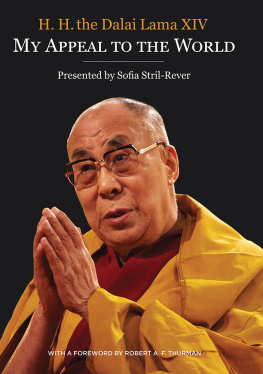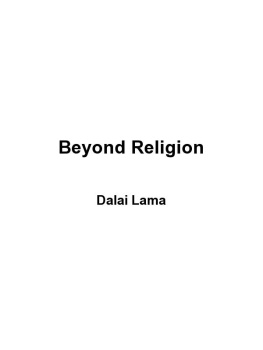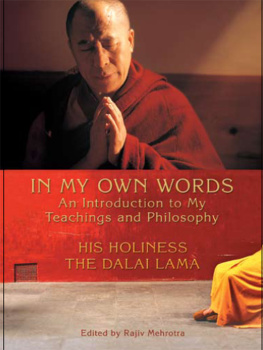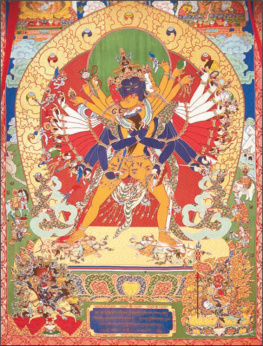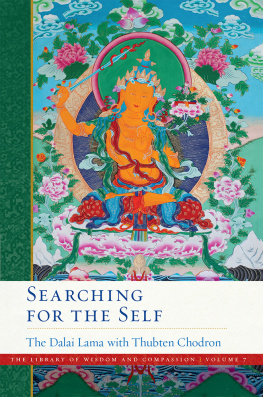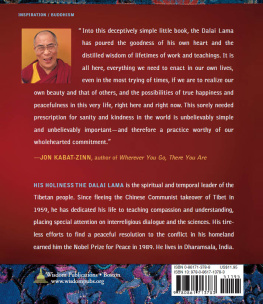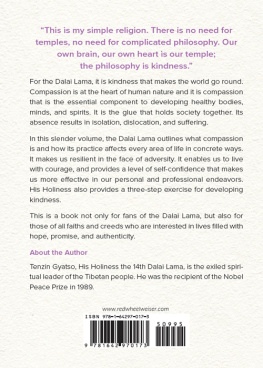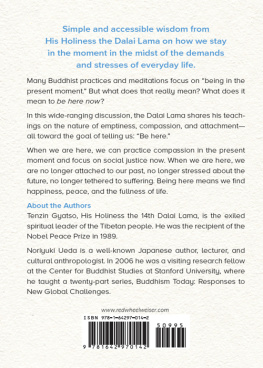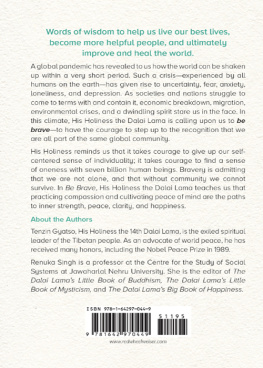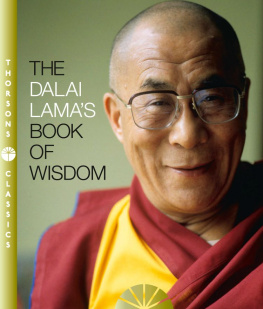His Holiness the Dalai Lama - How to See Yourself As You Really Are
Here you can read online His Holiness the Dalai Lama - How to See Yourself As You Really Are full text of the book (entire story) in english for free. Download pdf and epub, get meaning, cover and reviews about this ebook. year: 2006, publisher: Atria Books, genre: Religion. Description of the work, (preface) as well as reviews are available. Best literature library LitArk.com created for fans of good reading and offers a wide selection of genres:
Romance novel
Science fiction
Adventure
Detective
Science
History
Home and family
Prose
Art
Politics
Computer
Non-fiction
Religion
Business
Children
Humor
Choose a favorite category and find really read worthwhile books. Enjoy immersion in the world of imagination, feel the emotions of the characters or learn something new for yourself, make an fascinating discovery.
- Book:How to See Yourself As You Really Are
- Author:
- Publisher:Atria Books
- Genre:
- Year:2006
- Rating:3 / 5
- Favourites:Add to favourites
- Your mark:
- 60
- 1
- 2
- 3
- 4
- 5
How to See Yourself As You Really Are: summary, description and annotation
We offer to read an annotation, description, summary or preface (depends on what the author of the book "How to See Yourself As You Really Are" wrote himself). If you haven't found the necessary information about the book — write in the comments, we will try to find it.
His Holiness the Dalai Lama: author's other books
Who wrote How to See Yourself As You Really Are? Find out the surname, the name of the author of the book and a list of all author's works by series.
How to See Yourself As You Really Are — read online for free the complete book (whole text) full work
Below is the text of the book, divided by pages. System saving the place of the last page read, allows you to conveniently read the book "How to See Yourself As You Really Are" online for free, without having to search again every time where you left off. Put a bookmark, and you can go to the page where you finished reading at any time.
Font size:
Interval:
Bookmark:


1230 Avenue of the Americas
New York, NY 10020
Copyright 2006 by His Holiness the Dalai Lama
All rights reserved, including the right to reproduce this book or portions thereof in any form whatsoever.
For information address Atria Books, 1230 Avenue
of the Americas, New York, NY 10020
ISBN-13: 978-0-7432-9869-8
ISBN-10: 0-7432-9869-1
ATRIA BOOKS is a trademark of Simon & Schuster, Inc.
Visit us on the World Wide Web:
http://www.SimonSays.com
Contents
Foreword
T his book by His Holiness the Dalai Lama stems from a basic Buddhist notion that love and insight work cooperatively to bring about enlightenment, like the two wings of a bird. The overarching theme is that self-knowledge is the key to personal development and positive relationships. The Dalai Lama shows us how, in the absence of true self-knowledge, we hurt ourselves through misguided, exaggerated notions of self, others, external events, and physical things. Even our senses deceive us, drawing us into attachment and negative actions that can only come back to haunt us in the future. The book details how to overcome these mistakes in order to live from a realistic knowledge of our healthy interdependence.
The first part of this book shows how to draw back the deceptive aspect of our experience like a curtain; other approaches, such as suppressing lust and hatred, may be helpful, but they do not address this root problem. By directing our attention to the false veneer that so bedazzles our senses and our thoughts, His Holiness sets the stage for discovering the reality behind appearances. Our tacit acceptance of things as they seem is called ignorance, which is not just a lack of knowledge about how people and things actually exist but an active mistaking of their fundamental nature. True self-knowledge involves exposing and facing misconceptions about ourselves. The aim here is to find out how we get ourselves into trouble, then learn how to intervene on the ground floor of our counterproductive ideas.
Buddhist psychology is known for its detailed descriptions of the minds workings, and His Holiness uses these insights in a practical way by helping readers catch hold of these processes through their own experience. His central theme is that our skewed perceptions of body and mind lead to disastrous mistakes, ranging from lust at the one extreme to raging hatred at the other, so that we are consistently being led into trouble as if pulled by a ring in our nose. By developing insight into this process, we can free ourselves, and those around us, from these endless scenarios of pain.
This part provides step-by-step exercises to develop our ability to recognize the disparity between how we appear to ourselves and how we actually are. Once we have recognized our warped assumptions for what they are, the second part of the book shows how to undermine them. The tools used to accomplish this transformation are renowned Buddhist reflections for questioning appearances, which the Dalai Lama illustrates with his own experiences. His Holiness guides readers through a variety of practical exercises to help us break down the illusions we have superimposed over and beyond what actually exists, and learn how to act in the world from a more realistic framework. This calls for valuing the interdependence of all things and appreciating the latticework of our relationships for the meaningful contribution it makes to our lives.
The books third part describes how to harness the power of meditative concentration with insight to achieve immersion in our own ultimate nature, which undermines our problems at their very foundation. The fourth and fifth parts discuss how people and things actually do exist, since they do not exist in the way we assume. The Dalai Lama draws readers into noticing how everything depends on thoughthow thought itself organizes what we perceive. His goal is to develop in us a clear sense of what it means to exist without misconception. Then the final part of the book explains the way this profound state of being enhances love by revealing how unnecessary destructive emotions and suffering actually are. In this way self-knowledge is seen as the key to personal development and positive relationships. Once we know how to put insight in the service of love and love in the service of insight, we come to the books appendix, an overview of the steps for achieving altruistic enlightenment.
This book itself is an illustration of Tibets contribution to world culture, reminding us of the importance of maintaining a homeland for its preservation. The light shining through the Dalai Lamas teachings has its source in that culture, offering insights and practices that so many of us need in ours.
Jeffrey Hopkins, Ph.D.Emeritus Professor of Tibetan Studies
University of Virginia
Introduction:
My Perspective
W hen we rise in the morning and listen to the news or read the newspaper, we are confronted with the same sad storiesviolence, wars, and disasters. It is clear that even in modern times precious life is not safe: I cannot recall a single daily news program without a report of crime somewhere. There is so much bad news nowadays, such an awareness of fear and tension, that any sensitive and compassionate being must question the progress we have made in our modern world.
Ironically, the most serious problems emanate from industrially advanced societies, where unprecedented literacy only seems to have fostered restlessness and discontent. There is no doubt about our collective progress in many areasespecially science and technologybut somehow our advances in knowledge are not sufficient. Basic human problems remain. We have not succeeded in bringing about peace, or in reducing overall suffering.
This situation brings me to the conclusion that there may be something seriously wrong with the way we conduct our affairs, which, if not checked in time, could have disastrous consequences for the future of humanity. Science and technology have contributed immensely to the overall development of humankind, to our material comfort and well-being as well as to our understanding of the world we live in. But if we put too much emphasis on these endeavors, we are in danger of losing those aspects of human knowledge that contribute to the development of an honest and altruistic personality.
Science and technology cannot replace the age-old spiritual values that have been largely responsible for the true progress of world civilization as we know it today. No one can deny the material benefits of modern life, but we are still faced with suffering, fear, and tensionperhaps more now than ever before. So it is only sensible to try to strike a balance between material development on the one side and development of spiritual values on the other. In order to bring about a great change, we need to revive and strengthen our inner values.
I hope that you share my concern about the present worldwide moral crisis, and that you will join me in calling on all humanitarians and religious practitioners who share this concern to contribute to making our societies more compassionate, just, and equitable. I say this not as a Buddhist or even as a Tibetan but simply as a human being. I also do not speak as an expert on international politics (though I unavoidably comment on these matters) but as a part of the Buddhist tradition, which like the traditions of other great world religions, is founded on the bedrock of concern for all beings. From this perspective, I share with you the following personal beliefs:
- That universal concern is essential to solving global problems
Font size:
Interval:
Bookmark:
Similar books «How to See Yourself As You Really Are»
Look at similar books to How to See Yourself As You Really Are. We have selected literature similar in name and meaning in the hope of providing readers with more options to find new, interesting, not yet read works.
Discussion, reviews of the book How to See Yourself As You Really Are and just readers' own opinions. Leave your comments, write what you think about the work, its meaning or the main characters. Specify what exactly you liked and what you didn't like, and why you think so.


